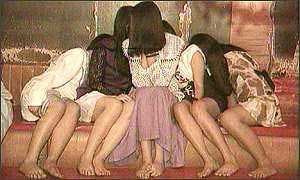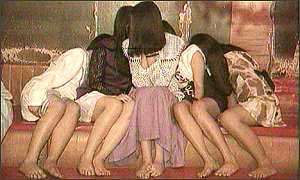Girls Trafficking
Jan 21, 2015
Story


“Don’t believe and talk with strangers. Don’t eat anything given by any strangers.” These are common words that my mother used to say me to make me aware of the incident that is happening around my society, “Girls trafficking”.
Maybe every mother alerts their daughters about this. I am very much familiar with this term, and I have thought that everyone knew about this. To make sure, I started the first step of my research by interviewing my colleagues in order to know whether they know the meaning of girls trafficking or not. I asked the students of group-D, F and A. To my great surprise, they didn’t know about girls trafficking. Their answers to girls trafficking were-“it means girls are beautiful and attractive” (Khaleda); another answer was “it means girls are not allowed to stay late at night and not allowing the girls what they want to do” (Jannat); another answer was “girls trafficking means girls working, living and playing together” (Rimu). These are the answers said by my friends. The educated girls are unknown towards such serious issues so these types of issues are likely to increase in a place where the girls are illiterate. After the interviews of my friends, they encouraged me to write the research paper on this topic. This research study mainly aims to find how women are used by men in the form of prostitutions. Also, this study tries to find out the possible causes for the issue.
Do we all aware of girls trafficking? Is it a serious issue? Yes, it is. Girls trafficking are found all over the world. Girls should not be the goods who are sold for money. Human beings are buyers and sellers, one who sell the girls for money as a business, and another is who buy the girls for having sex.
What comes in your mind when you hear the word girls trafficking? What is girls trafficking? Girls trafficking are to sell the girls in brothels where the physical bodies of girls are sold for money. Girls’ trafficking means the selling of young girls and transferring them into the brothels and forcing them to work as prostitutes. According to an estimate, “2.7% of prostitutes in India are Bangladeshi, the largest population of foreigners. The majority of these females are under 18” (social welfare board of India). “3000 Bangladeshi women are in brothels in Calcutta, India” (Human smuggling from Bangladesh at an alarming level).
During my research, I found that parents sell their daughters for money, and it is also as unfortunate that they sell their daughters to girls’ traffickers due to absolute poverty. On the webpage about Bangladesh is world’s major supplier of prostitutes, it states “a young girl was sold by her mother to a trafficker for 10,000 takas. Families are targeted who have daughters eligible for marriage and are very poor. There is a demand for Bangladeshi girls” (Daily Sangbad Report). Girls trafficking happen every day, and we see the news most of the time about this issue; however, we do not concerned, or we are indifferent towards this issue. The innocent girls are not only sold by their parents but also deceived by the traffickers.
Girls are trafficked by the traffickers who are most typically men in their twenties or thirties and forties who have travelled the route to the city or town several times and know brokers to contact. On the webpage about Bangladesh is world’s major supplier of prostitutes, it states “Male and female traffickers are sometimes referred to as ‘dalals’ and ‘dalalis’ who either employed by a brothel owner directly or operate more or less independently” (Firoze, Fawzia, Salma). Traffickers usually deceive women or lure them with the false promises of jobs, and the girls who desperately need money easily believe the traffickers and agree to go wherever they want to take them. These poor and innocent girls agree to leave their families relying on these false promises.
According to the website about the statics and facts of girls trafficking in Bangladesh, it states “Forms of trafficking: fake marriages, sale by parents to “uncles” offering jobs, auctions to brothel owners of farmers, abduction. In the last years, it is estimated that 200,000 women and girls have been trafficked from Bangladesh to Pakistan continuing at a monthly rate of 200-400 women” (Facts and Statistics, Coalition Against Trafficking In Women). As a result, these victim girls find themselves prostitutions against their will. The main causes of phenomenon of girls trafficking are ultimately poverty, lack of female empowerment and a high rate of illiteracy of especially female in Bangladesh and also unemployment because traffickers are involved in this work because of unemployment and the girls should be aware of these kinds of traffickers.
The girls face problems after they are sold in the brothels. Nobody wants their physical body touched and being exploited by others without their consent. Expert testimony and public opinion tell us that after being sold in brothels, girls have to whatever the owner of the brothels says. Physical abuse of girls can result in serious and dreadful health problems. They suffer from various diseases; for example, HIV, which is a life threatening disease, breaking bones, which is another critical injury, may change women lives roughly. When the trafficked girls find themselves in prostitutions, they try their best to escape from the hatred place of prostitution. Some of them are being threatened, some of them are being tortured, and some of them cannot tolerate the sexual exploitation. For these reasons, most of the girls in the prostitutions commit suicide. According to Donna M. Hughes, a small girl committed suicide because she could not bear the physical violence on her. When she came to a brothel, she had to dress like a bride for selling. She was sold by the brothel owner to a highest bidder. After that she committed suicide (Hughes, Claire)
In the article, ‘Attitudes towards HIV-positive trafficked women’, it states, “girls have to deal with 10-20 customers every day.
Among all of these problems the girls face the dangerous and incurable disease like AIDS. In 1995, World Health organization estimated 26,000 HIV-positive adults, whereas unofficial estimates claim that there are 20,000-25,000 infected Bangladeshi and 60-70 percent of prostitutes or girls return from India carrying AIDS” (Jay G, Michele R, Jhumka). It is the large number of people which reflects the lack of awareness about AIDS and increasing girls trafficking. Most of the girls who are sold in brothels suffer from AIDS and they are not allowed to stay in brothel, and they return back home. Though they return back to their home, they are neglected by the family and the society. Not only that girls in prostitutions has to take drugs to look fat and healthy. Asha, works in a bro a brothel in Faridpur, is 19 years old. She started to take cow drug because she was told that by her madam of the brothel that the drug will make them “fairer”.
Asha works in faridpur. Asha thinks that after taking the tablet she has become healthier. She told that she is leading a miserable life there. “How can I be happy here? God knows there is no happiness here” (Humayun Kabir). In the prostitutions, trafficked girls, who give up their hopes, desires, and dreams, wait for their customers to be abused, suffered, and distressed.
Girls’ trafficking has become a terrible issue for most of the Asian countries including Bangladesh, India, Nepal, Cambodia, and Sri Lanka. Girls’ trafficking means the selling of young girls and transferring them in to the brothels and forces them to work as prostitutes or slaves. In the prostitutions, girls are being physically and mentally harassed. Even though women have rights in leading their lives, most of them do not get freedom to lead their lives peacefully and their own ways. They are being neglected from the rights of sexual integrity. The sexual abuse of women can be protected only if we all people in the world concern about the matter. However, people do not respect to those women who work as prostitutes. Lack of social awareness and degrading social awareness about girls trafficking has created such problem.
On the webpage about ten reasons trafficking victims can’t leave, it states, “Victims from all cultures and in both sex and labor cases may be profoundly ashamed about their victimization. The trafficker may have told them that their family no longer wants them, and they have no place to go” (humantrafficking.change.org). According to the webpage, girls who are being trafficked and harassed physically embarrass for persecution. They think that their families will never agree to accept them and deny them as family members. The deceivers, who kidnapped the girls and shift them in to the hell of prostitution, tell them their families will never accept them after being raped or having sexual or physical harassment. Therefore, all of you as human beings have to do are look in these girls’ eyes to know that they are not happy; they do not choose the profession of prostitution by their own. Then, you will know how agonizing for a woman to be physical harassed or raped.
To sum up, elimination of trafficking in girls for prostitution and eradicating other problems faced by women like kidnapping, rape, sexual harassment is very important in present. Sexual exploitation is one of the most inhuman issues existed in our society and all of the women’s should be aware of this problem. Due to a pervasive lack of female empowerment, Bangladesh is facing an enormous dilemma regarding the phenomenon of girl trafficking representing a major crisis in the country especially as the threat of AIDS. I learned many things about girls trafficking while doing research on this which made me sad to know the situation of girls who are trafficked which I didn’t know before. After this research, feeling of helping those girls and awaring the illiterate girls arose in my mind. Furthermore, I am curious to know about the struggle they have to do after returning back from the brothel to their society. The research on girls trafficking encouraged me to work on this field to help the trafficked girls and raise awareness about this problem mostly in the rural parts of Bangladesh in the future.
Sources:
Akter, Khaleda. Personal interview. 1st June,2010
Byadya, Rimu. Personal interview. 1st June, 2010
Jannat, Naima. Personal interview. 1st June, 2010
"Gender and Human Trafficking." United Nations Economic and Social Commission for Asia and the Pacific. Web. 02 July 2010. http://www.unescap.org/esid/gad/issues/trafficking/index.asp.
Firoze, Fawzia Karim, and Salma Ali. "Bangladesh Is World's Major Supplier Of Prostitutes." Newsgroups.derkeiler.com: The Source for Newsgroups News. Bangladesh Country Paper: Law and Legislation. Web. 02 July 2010. http://newsgroups.derkeiler.com/Archive/Soc/soc.culture.bangladesh/2007-05/msg00002.html.
"Human Smuggling from Banglsdesh at Alarming Level." Newsgroups.derkeiler.com: The Source for Newsgroups News. 26 May 1997. Web. 06 July 2010. http://newsgroups.derkeiler.com/Archive/Soc/soc.culture.bangladesh/2007-05/msg00002.html.
"Trafficking in Women and Children: The Cases of Bangladesh." Daily Sangbad Report. 16 Aug. 1993. Web. 2 July 2010. http://newsgroups.derkeiler.com/Archive/Soc/soc.culture.bangladesh/2007-05/msg00002.html.
Bangladesh Is World's Major Supplier Of Prostitutes." Newsgroups.derkeiler.com: The Source for Newsgroups News. Web. 02 July 2010. http://newsgroups.derkeiler.com/Archive/Soc/soc.culture.bangladesh/2007-05/msg00002.html.
"Facts and Statistics » Coalition Against Trafficking In Women – Asia Pacific (CATW-AP)." Coalition Against Trafficking In Women – Asia Pacific (CATW-AP) » Fighting Sexual Exploitation, Promoting Women's Human Rights. Web. 03 July 2010. http://www.catw-ap.org/programs/research-documentation-publications/facts-and-statistics/.
Hughes, Donna M., and Claire M. Roche. "The Coalition Against Trafficking in Women." Ed. Donna M. Hughes. The University of Rhode Island. Web. 01 July 2010. http://dhughes@uri.edu.
Silverman, Jay G., Michele R. Decker, and Jhumka Gupta. "JAMA -- HIV Prevalence and Predictors of Infection in Sex-Trafficked Nepalese Girls and Women, August 1, 2007, Silverman Et Al. 298 (5): 536." JAMA, the Journal of the American Medical Association, a Weekly Peer-reviewed Medical Journal Published by AMA. 14 June 2010. Web. 18 June 2010. http://jama.ama-assn.org/cgi/content/full/298/5/536.
Tutul, Humayun Kabir. "Human Trafficking in Bangladesh and beyond - Worldpress.org." Worldpress.org - World News From World Newspapers. 3 Oct. 2008. Web. 01 July 2010. http://www.worldpress.org/Asia/3256.cfm.
"10 Reasons Trafficking Victims Can't Leave." End Human Trafficking | Change.org. Web. 28 May 2010. <http://humantrafficking.change.org/blog/view/10_reasons_trafficking_vict...




